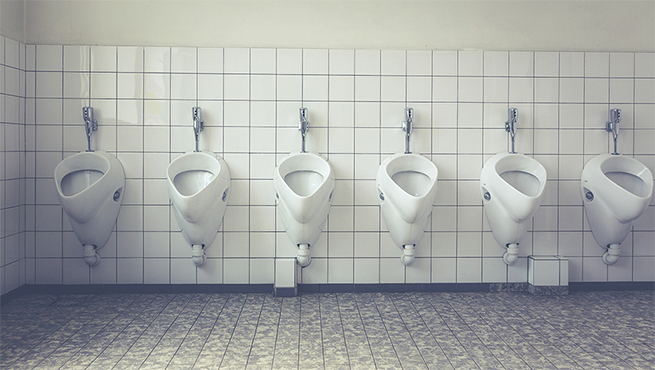Eight ways to make urinals more efficient
Urinals can account for about 20% of water use in offices.
The 1999 Water Regulations stipulate that there should be a maximum water usage of 7.5 litres per urinal bowl per hour and that a device should be fitted to prevent the urinals flushing when the building is unoccupied. However, in practice, flush rates are often adjusted, in an attempt to reduce odour or blockages, and flushing can continue for 24 hours a day, seven days a week. For some offices and buildings, this may mean that 76% of flushing occurs when the building is unoccupied. Urinals therefore often flush regardless of use, wasting a lot of water, especially out of hours.
Typical uncontrolled flushing of urinals is three times an hour, which with a 7.5 - 12 litre cistern will be using 197 - 315 m3 water per year. In companies where the urinals operate without flush control, based on 100 male staff working 260 days a year, savings of over £3,800 per year in water and sewerage costs can be achieved by installing passive infrared sensors at a cost of around £350 - a payback of five weeks.
Flush control technologies
New flush control technologies include timer controls, which can be set to match the hours the urinals are in use. Infra-red or ultrasound sensors have also been developed which work by detecting the presence of people, providing supplies precisely when required. Similarly, some urinal flushing systems may be triggered by variations in water pressure or flow, caused by taps being used.

Manual shut-off
A single valve such as a quarter turn ball valve can be installed in the pipework supplying the washroom. This can reduce water use by over 75%* and is a low-cost option, however, it is only applicable if work hours are predictable and it requires staff reliability.
Timer and solenoid valve
A timer and solenoid valve can be installed on the pipework connected to the urinals so that water supplied to the cisterns is shut off during periods of non-use. This option can reduce water use by over 75%* is another low-cost option, but again is only applicable if work hours are predictable.
Pressure sensitive hydraulic valve / pressure reducing valve (PRV)
A pressure sensitive hydraulic valve can be fitted to the inlet pipework of the urinal system and can reduce water use by over 75%. This is a retrofit option and the valve remains closed when pressure remains unchanged (i.e. when urinal is not being used). When the inlet water pressure temporarily decreases through water being used elsewhere in the washroom, the diaphragm-operated valve opens, allowing a pre-set amount of water to pass into the urinal cistern.
A disadvantage of this system is that flushing is related to occupancy of washrooms rather than use of urinal**.
Passive infrared (PIR) sensor
A motion sensor is placed above the urinal to detect use. This controls a solenoid valve to allow a pre-set volume of water into the cistern per use. When the cistern is full, the auto-siphon will automatically discharge and flush. Again installation is less expensive at around £120 and can reduce water use by over 75%*.
Waterless urinals - retrofit
Siphonic trap - contains a barrier fluid that is inserted in the urinal bowl. The urine passes through the siphon and drains to the sewer, while the low-density barrier fluid (a deodorising disinfectant) remains in the siphon. This option can reduce water use by up to 90%***, is a cost effective retrofit option costing between £80 - £90 per unit and is easy to install, however, it requires specialised cleaning and the barrier fluid has to be replaced every one to two weeks depending on use (operating costs, excluding water are around £20 - £45 per urinal per year).
Deodorising pad- a pad impregnated with a deodorising chemical is inserted into the urinal outlet. The major disadvantage with this is that the pads have to be replaced and disposed of every week, depending on use. This costs around £30 per urinal per year.
Biological- cartridge containing a microbial stick is fitted into the urinal bowl or trough to break down urine and biofilm. The principal disadvantage to this system is that the stick dissolves and needs to be replaced 3 to 4 times a year, depending on use.
Air flush- Individual traps are replaced by a single trap at the drain end. A low wattage DC fan provides air flow down the bowl to prevent odour. The waste pipes are specified at 50 mm minimum and installed at 1:18 fall to prevent scale build up.
Water use can be reduced by up to 90%***. Unfortunately, this option is not suitable as a retrofit, but it doesn't use chemicals, the single traps are easy to clean and the fan uses the same power as mains powered urinal controllers.
* Based on an eight hour working day, 260 days a year
** Can also be affected by changes in pressure resulting from use of other facilities supplied on the same water supply pipe
*** Water may still be required for hygiene flushing or cleaning
